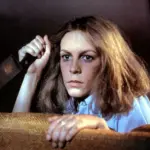Ari Aster's second feature film, "Midsommar," follows in the footsteps of his debut, "Hereditary" (2018). While it may not have the same jaw-dropping impact as Hereditary, it certainly doesn't disappoint. Both films share a common essence that can be summed up in two words: calm and composed. Finding a director who can approach horror with such poise is rare. Most horror films are frantic, desperate to shock the audience every few minutes with sudden scares or twisted imagery to jolt the senses.

What sets Aster apart is his complete rejection of these rudimentary horror techniques. His films rarely use jump scares; most shots are slow and deliberate. Aster is more interested in crafting a psychological terror far more complex than mere physiological fear. To achieve this, he employs restraint, subtlety, and a systematic approach that gradually pushes the viewer into deeper layers of anxiety.
Take, for example, a scene in Hereditary where the young boy Pelle discovers his father's charred corpse in the living room. This sequence is a masterclass in suspense, featuring three consecutive scares. In the hands of a lesser director, these scares would be less densely packed, and the pacing would likely be quicker.
Let's examine how Aster handles this scene. First, the camera follows Pelle's gaze as it slowly pans across the room, revealing the burnt corpse lying by the fireplace, with only the ring on the charred hand glinting in the light—this is the first scare. The camera then cuts to Pelle's face. In the out-of-focus background, we gradually notice his mother, possessed by an evil spirit, creeping along the wall. As the focus shifts, the demonic figure becomes clearer. The camera then pans again, following Pelle's gaze to the left, where he sees a naked, sinister-looking man standing in the doorway.

Each scare enters the frame slowly, without any close-ups or exaggerated sound effects. The critical element here is creating what can be described as a "field of fear." This field is composed of both time and space. Time seems to slow down, as if fear refuses to leave, dragging out each moment. Spatially, the corpse in front of Pelle, the possessed mother behind him, and the eerie figure in the doorway form a triangular trap, encircling Pelle and leaving him with no escape. This masterful construction of terror is what truly grips the soul.
We often hear the term "elevated" to describe something refined and impactful. In the context of horror, Ari Aster's technique is the epitome of elevated filmmaking. And the sophistication doesn't stop there.
You can often gauge a director's talent within the first minute of their film. The opening minute of Hereditary is a testament to Aster's genius. The camera starts outside a treehouse, pans into the interior, and smoothly transitions from a shot of a dollhouse to the actual room where the story begins. This seamless shot is not just clever but also profoundly metaphorical. It equates the characters' home to a dollhouse, suggesting that the protagonists are mere puppets manipulated by external forces. And who is pulling the strings? The evil spirit is hidden in the treehouse, observing and controlling everything. The house is nothing more than a dollhouse at its mercy. With this single shot, Aster captures a sense of predestination—the characters are doomed from the start, subject to a supernatural force beyond their control.
At the same time, Aster's exploration doesn't stop at the supernatural. He delves into the realistic disintegration of a family, showing how they gradually fall apart. While the spirit's influence is inescapable, the seeds of the family's downfall were sown long before, allowing the evil entity to exploit its vulnerabilities. This dual narrative—blending supernatural horror with a family's raw, emotional unraveling—gives Hereditary its sophisticated edge.
The fear it creates isn't just an external force, nor is it simply about demonic possession. Instead, it reveals the internal violence and cruelty that festers within a family. This violence is hereditary—not passed down through genes but through psychology and behavior. Even without the presence of an evil spirit, this family is distraught.

The grandmother is a control freak who drove her son to his death, leading her daughter to distance herself. The toxic parent-child relationship resulted in the daughter trying everything to avoid motherhood, even attempting to abort her pregnancy. Despite her efforts, she became a mother, having a son and a daughter. Still, the deep-seated rejection in her subconscious nearly led her to burn them alive while sleepwalking.
These issues are like thorns embedded in the walls and floors of the house. A slight misstep and disaster strikes. The evil spirit is merely a catalyst. It's only after the spirit intervenes and the younger daughter dies in a tragic accident that the family ultimately falls apart.
The most terrifying moments of this film aren't the supernatural scenes, the charred corpses, or the ant-covered faces. Instead, they are the two most mundane scenes. In one, after the daughter's death, the three remaining family members sit at the dinner table in heavy silence. Suddenly, a fierce argument erupts between the mother and son, with mutual accusations. The mother blames the son for being cold and irresponsible.
In contrast, the son accuses the mother of being overbearing and emotionally distant. The scene ends in a bitter silence. The other scene is even more brutal: the mother stands by her son's bed and admits, "I never wanted to be your mother." That's where the absolute horror lies.
Horror is not just about the unknown; it's about realizing what you thought you knew was never confirmed. It's like seeing the people closest to you suddenly become strangers or feeling your home transform into a cold tomb.
Take, for example, the scene where Pelle finds his father's charred corpse in their living room while his possessed mother lurks behind him. This is the last reunion of the family of three, but none of them are the same as they once were. Is there anything more chilling?
Much like "Hereditary," "Midsommar" delves into cults, sacrifice, and spells themes. More importantly, the story of "Midsommar" begins with a family tragedy. The protagonist, Dani's sister, suffering from severe psychological issues, murders their parents before taking her own life, leaving Dani alone in the world. Soon after, Dani, her boyfriend, and their friends travel to a remote Swedish village called Hårga to attend a once-in-a-lifetime midsummer festival. But as the festival progresses, the seemingly idyllic village life unravels, and its buried secrets pull everyone into an inescapable abyss.
Ari Aster’s perspective is unique. He sets the story in a place where the nights are short and the days are long, where only fairy tales should unfold. Everything happens in broad daylight, in a crystal-clear environment. The villagers wear pristine white robes and live a self-sufficient life. They have their philosophy and religion, believing that human life is divided into four seasons, each lasting 18 years. When someone reaches 72, they willingly leap to their death in front of everyone, seeing it as the most natural return to the earth.
They practice ancient fertility worship, periodically bringing in new members as seeds and vessels for the next generation. They are unapologetically proud of their way of life and welcome outsiders. Still, they offer them only two choices: stay or disappear forever.

As modern individuals living in a world shaped by civilization, both the protagonists in the film and the audience naturally perceive the small town as primitive. Yet, what's fascinating is that Ari Aster's direction carries no hint of mockery towards this town; instead, he evokes a sense of inevitable divinity. As the story unfolds, the characters and the viewers might momentarily forget the distinctions between civilization and savagery, accepting the town's existence as rational. This is a profoundly unsettling realization—it reminds us of a terrifying truth often obscured: the only thing more frightening than raw, extreme violence is violence shrouded in benevolence.
On the other hand, this perspective also serves as a critique of modern civilization. If we carefully retrace the narrative of "Midsommar," we discover that the film is about a girl, Dani, who finds and integrates into a more prominent family after losing her small family. At its core, this journey deconstructs various social relationships within modern civilization.
The first relationship to crumble is familial; Dani loses all her immediate relatives. Next is her romantic relationship—Dani's boyfriend is irresponsible, eager to leave her, but too cowardly to do so. Following this, friendships fall apart; the friends in the film don't honestly care for each other, quickly turning on one another over trivial matters and even engaging in bitter disputes over academic credit.
In this web of complex social dynamics, Dani is fundamentally alone. She has no one to confide in or lean on as she grieves her family's loss. That is until she arrives in Hårga. The most significant difference between this town and modern civilization isn't the inhumane rituals of sacrifice but how individuals are reintegrated into a collective whole, where a group of people lives as if they were one entity. If Hårga is seen as a single living organism, everything makes sense. Whether birth, self-sacrifice, or eliminating outsiders, it's all part of this organism's renewal process.
Moreover, the town's residents possess a profound, unified capacity for "empathy." When one person is sad, everyone cries; when one is happy, everyone laughs; when a couple engages in sexual intimacy, everyone joins in the call of life. In essence, this town provides the emotional solace lacking in modern society—the assurance that "you are not alone." This is what ultimately draws Dani inescapably to the city. She sacrifices her boyfriend and chooses to stay, smiling at the camera with relief. You could say she's been brainwashed, but to her, it's simply a return home.
From these two films, we can discern Ari Aster's brilliance. His horror movies may seem to involve supernatural elements, but at their core, they are deeply rooted in realism. He deftly captures the most mundane aspects of emotions, daily life, and human relationships, then introduces an external, terrifying force to expose the fragility of these emotions. This relentless attack on our sense of security is Aster's particular brand of dark humor and the essence of what makes his films so haunting.
It's too easy for a horror movie to "scare" audiences. The real challenge is what Ari Aster achieves—leaving you with a lingering sense of dread, a chill that lingers long after the credits roll. True horror is when the "known" is reverted to its original, "unknown" state. This is what Ari Aster's horror films teach us.





















































View replies 0